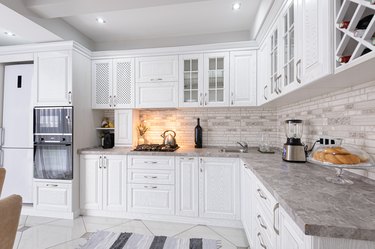
Removing sticky contact paper from kitchen cabinet shelving or facades can feel like a rather daunting endeavor. The smooth, slick surface can be firmly attached to the kitchen cabinets and come off in pieces or not at all.
Contact paper, stickers, strips of tape and other adhesive products that refuse to loosen their grip on the front or insides of the kitchen cabinets can be easily pulled away from the kitchen cabinets with the right techniques. The right methods and tools can also ensure that the underlying material doesn't suffer any damage from the removal process.
Video of the Day
Video of the Day
Heat to Remove Contact Paper
The contact paper that lines the cupboard shelves and kitchen drawers protects the wood or other cabinet material. But it can become dated, torn or begin to lift from the corners and sides. The contact paper can be lifted from the surface with a good heat source. Lift an edge or corner of the contact paper sheet or stuck-on label. Peel back as far as you can without pulling up the finish or marring the surface of the kitchen shelving or inner drawer.
With the edge or corner lifted, apply low heat with a hairdryer beneath and under the contact paper. Slowly bring the heat up, making sure it isn't damaging the surface. This will warm the adhesive and allow it to release its hold on the cabinetry. Cabinetry with a veneer or finish can be damaged by high heat applied directly to the material, so check a small hidden space before trying this method if you aren't sure.
Gently tug the contact paper away from the surface of the kitchen cabinet shelving as the adhesive heats up. Slowly work across the sheet of contact paper or sticker until it pulls free from the cabinets. If the contact paper continues to flap back down, then a piece of plain paper can be slipped under the edge and used as a sort of tab. This process tends to leave behind a film or sticky residue that will need to be cleaned before placing items back in the cabinet or replacing the contact paper.
Polish to Remove Adhesive
Stained wood or kitchen cabinets with a polished veneer may need a gentler approach to completely remove the residue left behind from removing contact paper. Furniture polish can pull bits of adhesive from stained wood cabinets, according to The Infinite Kitchen.
Spray the polish onto the shelving and rub away with a clean cloth. If this process leaves behind a haze on the cabinetry, then clean the surface with mild dish soap and warm water.
Cleaning Adhesive From Kitchen Cabinets
Rubbing alcohol works well to remove the residue left behind from common adhesives. Merry Maids notes that it is strong enough to pick up sticky substances while not harming wood or other kitchen cabinet material by leaving behind a layer of excess moisture.
Dip a clean, soft cloth in household isopropyl alcohol and rub across the surface of the shelving using small, circular motions. Wipe the kitchen cabinetry down with a clean, dry cloth and buff dry.